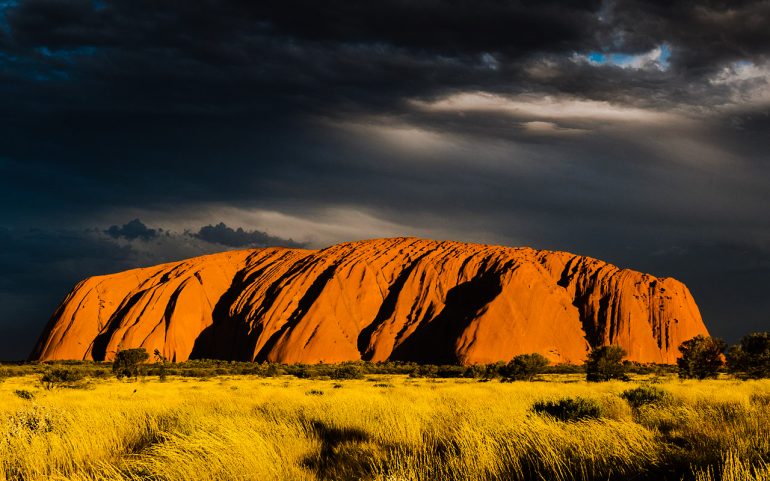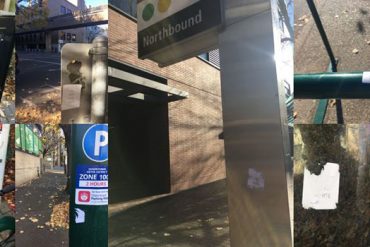“Please don’t climb,” reads a sign greeting tourists approaching Uluru Rock, standing as a subdued effort by the Anangu aboriginals to deter the violation of their sacred site.
Uluru Rock is an immense sandstone monolith in the heart of the Northern Territory in central Australia. Its enormous crimson mass dominates the arid landscape, rising 348 meters above ground—higher than both the Eiffel Tower and the Chrysler Building—with a ten-mile circumference, not to mention the 2.5 unseen kilometers extending underground. Uluru’s magnitude, however, is not solely owed to its immense size. Uluru was first revered by the Anangu Aboriginal people as a sacred site believed to be shaped by their ancestors. In the past 70 years, this sacred site has been repurposed by Piranpa, or “white people” in Pitjantjatjara, as a tourist attraction. Chains and ropes were hammered into the rock so tourists can climb to the top and take photos. Motels, airstrips, and roads were developed to accommodate the traffic. For decades, the Aboriginal people have battled for ownership, rights, and respect restored to the land. After a series of portioned victories and unabated struggle, the Anangu people can finally see a ban placed on climbing Uluru in sight.
Uluru is believed by the Anangu to have been molded by ten ancestors during Tjukurpa, or, in the poor English translation, “Dreamtime.” Before these ancestors walked its surface, the world was a featureless place. The Anangu say that these Anangu ancestors, or spirit people,began shaping the land as they explored it, creating formations like Uluru along their way. Uluru is esteemed as one of the most prominent sites; the aboriginals believe they can connect with Tjukurpa and receive blessing from their ancestors just by touching the stone.
Uluru, the Anangu, and their encompassing lands had long been left in peace due to their isolated location, but ever since white men’s first contact with the area, the Anangu people have seen this site seized and degraded for profit, and have been in steady struggle over the region.
The first white men visited the region in the early 1870s and named Uluru, Ayers Rock, and Kata Tjuta (another prominent, sacred feature) Mount Olga. Due to the landscape’s harsh conditions, the area didn’t see much Piranpa traffic. In 1920, the region containing Uluru was declared the South West Reserve within a system of Aboriginal reserves established as sanctuaries. In 1940, the reserves were minimized to make way for mining development, and a dirt track leading to Uluru was carved eight years later, opening the floodgates to tourists and miners who made regular trips to exploit the unprotected, sacred land. The Australian Commonwealth recognized the rich opportunity for tourism in the area, and removed Uluru and Kata Tjuta from the protection of the Reserve, deeming it a park functioning under government legislation. As their world and Tjukurpa were signed away and converted to an attraction, the Anangu people took up arms in an unwavering fight to take back their land and rights.
Eventually, after a series of meetings, the territory was declared a National Park under the National Parks and Wildlife Conservation Act of 1975, and ownership was transferred to the Australian National Parks and Wildlife Service in 1977. The battle for ownership continued, and in 1979, possession of the peripheral lands surrounding Uluru and Kata Tjuta were restored to the hands of the traditional owners, but the National Park territory containing their sacred sites was excluded. This fruitless victory led to three years of lobbying by Anangu councils and officials to amend the claim and the bureaucracy that barred them from full ownership. Aboriginal Australian artist and activist Vince Forrester stated in 1983 in the Financial Review, “We want Uluru back. but not under [these] proposals…We want total management. We want land rights as land rights are supposed to be and not watered down.”
After three years of debate without consensus, Prime Minister Robert Hawke announced the handback, sparking controversy and opposition from Northern Territory government and tourism industry who feared that the transfer would threaten their capacity to capitalize on the park. The following years witnessed a series of political battles as the Anangu remained unyielding, all the while repeating to the public that their intentions as owners would not hinder tourist operations. Finally, on Oct. 26, 1985, hundreds of Anangu and Australian civilians gathered to witness the ‘handover’ as the title deeds were passed to the Traditional Owners at the base of Uluru.
This was a massive victory for the Anangu people and for Aboriginals across Australia. As he announced his intentions for the handover in the Launceston Examiner in 1983, Prime Minister Hawke remarked, “This is a historic decision and is a measure of the willingness of the Government, on behalf of the Australian people, to recognize the just and legitimate claims of a people who have been dispossessed of their land but who have never lost their spiritual attachment to that land.” While this statement rings true and the handover set in motion closer ties and communication between the Australian government and the Anangu people, their land continued to be exploited and their voice continued to be muffled under politics and agendas. After the handover, the traditional owners leased the territory back to Commonwealth, initiating joint management of the National Park. This allowed sacred sites like Uluru and Kata Tjuta to remain as tourist destinations.
Before the repossession of Uluru, chains were hammered into the rock to assist tourists in their climbing the rock. Climbers have since consistently summited the rock, an inherently disrespectful act that has left a path of rubber from the soles of shoes that track up the rock and are visible from miles away. Furthermore, the tourist traffic and lack of waste facilities have left trash and a stench of urine in the area. Aside from the tourism’s violation of the site, over 30 climbers have died in their attempts to summit Uluru in past decades. Nevertheless, the treatment of Uluru has been a consistent conflict between the Anangu and the Commonwealth, and the Aboriginal community has argued for years for a ban be placed on climbing Uluru.
The Anangu people report that they have felt coerced and pressured by the government over the issue. “Over the years Anangu have felt a sense of intimidation, as if someone is holding a gun to our heads to keep [Uluru] open. Please don’t hold us to ransom,” Chairman of the park board and traditional Uluru owner, Sammy Wilson, stated in The Guardian. Aboriginals have placed a sign as the trailhead leading to the monolith that reads “Please don’t climb;” however there has never been any jurisdiction prohibiting climbers. The sacredness of the site has been acknowledged without action, and has even been capitalized on by the tourism industry. Tours drive around the rock to look at ceremonial sites where the Anangu continue to perform rituals. The Uluru Travel Guide website trivializes the Aboriginal significance of the site by equating it to the tourist’s appreciation. It says, “Uluru as it is known to the indigenous Aboriginal people, is a very sacred place. But visitors from around the world who come for an Ayers Rock tour have no trouble relating to the magic and power of this formation.” The site later writes, “The Aboriginal people would prefer visitors to stay off their sacred site, but there are marked trails leading across and atop Ayers Rock. Visitors who aren’t deterred by the cultural warnings will get spectacular views from the top of Uluru.”
The recent push to prohibit climbing Uluru is residual from the Park’s management plan for 2010-2020 that proposed that a ban be placed if fewer than 20 percent of tourists climbed the rock. It was reported that between 2011 and 2015, only 16 percent of visitors climbed, setting forth the announcement that a ban will be placed on Uluru on October 26, 2019, a date chosen to celebrate the 34th anniversary of the handover. This decision breathes a sigh of relief and shout of triumph throughout the Anangu and Aboriginal community. The ban marks an end to a 70-year conflict between the Anangu and a government that consistently placed dollars over indigenous rights. The exploitation, stifling, and ensuing struggle of the Anangu reflect a similar battle fought by indigenous communities across the world as they grapple with their local governments for rights and respect to their lands and community. Unfortunately, very few of these battles bear the same fruits that we have seen today in Australia. The Sherpa have been in constant conflict with the Nepali government over the unjust treatment of their community and their sacred Himalayan land. After a series of protests and strikes, they have seen very little progress in their movement rights and respect. The Standing Rock Reservation ten-month protest against the Dakota Access Pipeline and the government’s heartbreaking disregard for their cries exemplifies the worldwide weight indigenous communities bear as they face threatening corporate and administrative interests. Although there is still much work to do in compensating the Aboriginal people, the Anangu people’s long-due victory of Uluru is an event to be celebrated and reverberated around the world in the strife of indigenous communities. The Anangu story should resonate in the minds of tourists as they appreciate sacred spaces and be echoed in government halls as legislation is imposed on sacred grounds.





